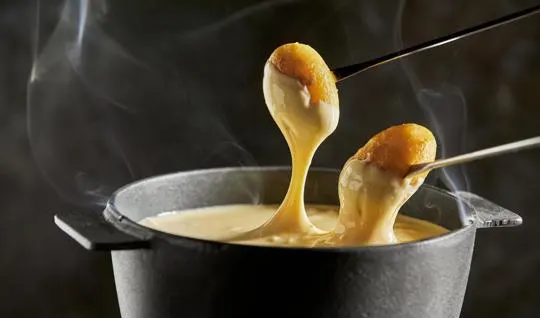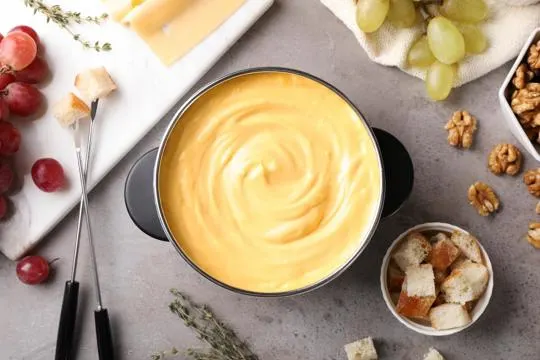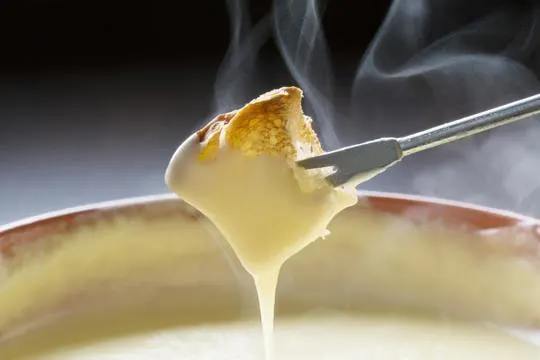Summary of key points
The main difference between fonduta and fondue lies in their origins, ingredients, and preparation methods. Fonduta is an Italian dish made from a blend of cheeses, eggs, and cream, while fondue is a Swiss dish made from melted cheese mixed with wine or beer.
Fonduta has a rich and creamy consistency suitable for dipping bread or vegetables, while fondue is usually thicker and used for coating meat or potatoes. Additionally, fondue can also refer to a type of communal dining experience where guests dip their food into the shared pot of melted cheese.
Alright, folks, we all love melting cheese, right?
Here’s the scoop on Fonduta and Fondue.
Both star cheese. Fonduta hails from Italy, bursting with fontina’s creamy goodness. Fondue? That’s Switzerland’s pride, a mix of Gruyère and emmental.
I’ve dribbled Fonduta on my keyboard before, trying to type with a fork in hand.
And yup, I’ve lost bread chunks in Fondue pots. Who hasn’t?
This is our deep-dive into these cheesy delights.
Ever wondered which one’s cheesier? Stick with us.
What is Fonduta?

Fonduta, a divine Italian dish, is unlike its Swiss cousin, fondue.
Packed with incredible flavors and creamy textures, it’s the epitome of indulgence.
Made by melting together assorted cheeses, eggs, milk, or cream, this delightful combination makes a great dip for bread or accompaniment to veggies or meat.
The key difference between fonduta and fondue lies in the cheese used.
Fondue often uses Swiss cheeses like Gruyère or Emmental, whereas fonduta incorporates Italian varieties such as Fontina or Asiago.
This difference provides different flavor profiles.
In addition, fonduta is usually cooked on the stovetop.
This method allows for more precise heat control and a smooth velvety texture.
Plus, the inclusion of eggs and milk/cream creates a luxurious consistency that coats each bite.
What makes fonduta truly unique is its versatility.
It can be enjoyed alone or with other dishes like pasta sauces or stuffed meats.
Its adaptability allows chefs to explore numerous possibilities and make delicious creations.
What is Fondue?

Fondue – a Swiss classic – is loved by foodies around the world.
It’s all about dipping bite-sized portions into a pot of melted cheese or chocolate.
The name ‘fondue’ comes from French – it means ‘to melt’.
Fondue is fun and social – everyone dips in and shares.
A fondue session is an experience.
Imagine a table with a pot of warm, creamy cheese or rich, melted chocolate.
The smell alone is enough to make your mouth water.
As you dip your bread, vegetables or fruit, you enjoy the mix of flavors.
Fondue is versatile.
Cheese fondue combines Swiss cheeses like Gruyère or Emmental with white wine and garlic.
Chocolate fondue includes sweet treats dipped into melted chocolate – heaven for chocoholics.
But fondue is more than food. It’s a celebration of togetherness.
Gather around the pot and share stories while savoring the flavors.
Whether it’s an intimate dinner or a casual get-together, fondue brings people together.
Did you know that other countries have their own fondue variations? In Italy, they have “fonduta” with regional ingredients like fontina cheese from Val d’Aosta.
It adds unique flavors and textures to the classic Swiss concept.
Differences Between Fonduta and Fondue

Fonduta and fondue may seem alike, but there are key contrasts.
Origin
Fonduta and Fondue both have deep roots in their respective countries.
Fonduta is a traditional Italian dish, while Fondue originated in Switzerland.
Fonduta, also known as fondue savoyarde in French, is a creamy cheese sauce made with ingredients like fontina cheese, eggs and milk or cream.
This dish has been around for centuries in Italy, particularly in the Piedmont region.
The name “Fonduta” comes from the Italian verb “fondere,” meaning to melt.
Fondue has a long history in Switzerland too.
It’s believed that Swiss villagers created this dish to use up leftover cheese in winter when fresh food was scarce.
The term “Fondue” comes from the French word “fondre,” meaning to melt.
However, there are some differences between Fonduta and Fondue.
Fonduta is usually made by melting cheese, eggs and milk or cream on low heat until smooth.
It’s often served as a dip or over vegetables or bread.
Fondue involves melting cheese (usually Gruyère or Emmental) with garlic and white wine in a pot called a caquelon over a small flame.
It’s usually eaten by dipping pieces of bread into the melted cheese using long forks.
Also, Fonduta is usually made with one type of cheese (fontina), while Fondue can involve different varieties.
Ingredients Used
Culinary ingredients are essential for defining the uniqueness of a dish.
Let’s explore the differences between Fonduta and Fondue.
Fonduta, an Italian classic, is made with luxurious ingredients such as cheese, eggs, butter, and milk.
These ingredients combine to form a velvety texture and taste.
Soft cheeses like Fontina and Gorgonzola are often the star of this dish as they provide depth and richness.
Its smoothness and decadence make Fonduta a delicious experience.
Fondue, from Swiss cuisine, is a versatile meal.
It usually consists of melted cheeses like Gruyère or Emmental, plus white wine or beer.
Garlic or nutmeg can enhance the aroma and flavor.
Chocolate fondue is another variation.
High-quality chocolate is combined with fruits such as strawberries or bananas for a yummy dessert.
The key difference between these dishes is their flavors.
Fonduta has a creamy richness from Italian cheeses, eggs, and milk.
Fondue has a savory flavor from different Swiss cheeses, wine, or beer.
Both dishes offer a delicious cheesy treat.
Flavor and Taste
Flavor and taste set Fonduta and Fondue apart. Fonduta is creamy with a nutty note.
Whereas, Fondue has a variety of flavors due to its ingredients.
Fonduta is velvety and melts in the mouth, with an indulgent cheesy aftertaste.
Fondue’s taste depends on the type of cheese, herbs, spices, or additives used.
This makes Fondue a culinary journey for daring food lovers.
Consistency and Texture
Fonduta and Fondue have distinct differences. Noticing these can help you decide which to have.
- Firstly, Fonduta is creamy and velvety, whilst Fondue is thicker and gooey.
- Furthermore, Fonduta includes yolks, butter and cream, making it extra rich and flavourful. Fondue mainly uses melted cheese for its taste.
- Lastly, Fonduta is served as a dip or sauce, and Fondue is eaten by dipping food into the melted cheese.
It’s up to you which experience you’d like.
Similarities Between Fonduta and Fondue

Fonduta and fondue – two dishes with similarities.
Both include melting cheese for a creamy sauce.
Usually served with bread or veggies for dipping.
Heating and melting cheese is the base of both.
Unique details to consider:
Fonduta is Italian, usually made with fontina cheese.
Fondue can use other cheeses, like Gruyere and Emmental.
Fonduta often has extras like eggs or truffles for flavor.
Fondue sticks to cheese and wine.
Though similar, fonduta and fondue have differences.
Knowing these helps one pick which suits their taste best.
Traditional Serving and Pairings
To show off the distinct flavors of these melting pot delicacies, traditional serving and pairings for fonduta and fondue are essential.
From crusty bread to roasted vegetables, the accompaniments make each bite even more delicious and add texture.
It also encourages conviviality among diners.
Whether it’s an Italian fonduta or a Swiss-inspired fondue, the art of pairing will make the experience more indulgent and delightful.
Artisanal crackers, seasonal fruits, charcuterie, or pickled vegetables are great for a twist.
To enhance the fondue experience, light-bodied whites like Chardonnay or Sauvignon Blanc are great.
They cut through the richness of the cheese and balance its flavors perfectly.
Pinot Noir or Beaujolais are great red wines to bring out the earthy notes while maintaining a refreshing contrast.
Champagne or sparkling wine is perfect for adding sophistication and elegance.
Its effervescence accentuates the creaminess and provides a palate-cleansing effect.
Fonduta hails from Italy’s Piedmont region and features rich local cheeses like fontina or Castelmagno blended with eggs.
On the other hand, Swiss fondues typically contain Gruyère and Emmental cheeses with white wine.
Traditional serving and pairings are key to enjoy these culinary delights fully.
Gather your loved ones around a bubbling pot and embark on a gastronomic journey.
Let your taste buds explore the realm of possibilities as you indulge in the art of fonduta and fondue.
Which is Preferred in Different Regions?
The fonduta or fondue debate rages on in different regions.
Culinary customs dictate which melted cheese dish takes precedence.
While some may go for creamy, rich fonduta, others may choose savory fondue.
In Italy’s Piedmont region, fonduta is a big deal.
It’s typically made of fontina, milk and sometimes egg yolks.
People usually dip bread or vegetables in it.
It can be found in Italian restaurants all over the country.
Fondue, on the other hand, is more popular outside Italy.
Swiss fondue is a renowned dish made of Gruyère and Emmental cheeses mixed with white wine or garlic-infused broth.
It’s perfect for coating bread cubes or vegetables.
Both types of fondues have a place in people’s hearts (and stomachs).
Regional preferences stem from cultural traditions and culinary heritage.
Chefs are taking it to the next level by coming up with fusion fondues.
They use different cheeses and local ingredients to cater to all tastes.
It’s hard to say which style is preferred in different regions.
It depends on personal taste and regional culinary customs.
Why not try both? Variety is the spice of life, and both fondues offer a delicious and interactive dining experience.
Conclusion
It is important to remember that fonduta and fondue both share a common history connected with Swiss culture, yet each has their own set of ingredients that give them distinct flavors.
Because of this, one choice might not be right over the other depending on what your goal is—some might choose to try both because they provide two different experiences.
Whether you’re looking for something light and cheesy or something that carves a savory path all the way home, fonduta and fondue are both excellent choices.
Both dishes add a unique spin to the traditional Swiss meal that cheers up any dinner party.
When it comes down to it, there’s no wrong answer when trying to decide which dish to enjoy; in fact, you could certainly enjoy both for a truly unique experience.
So step out of your comfort zone and enjoy the inspired spin on two classic dishes.

Leave a comment